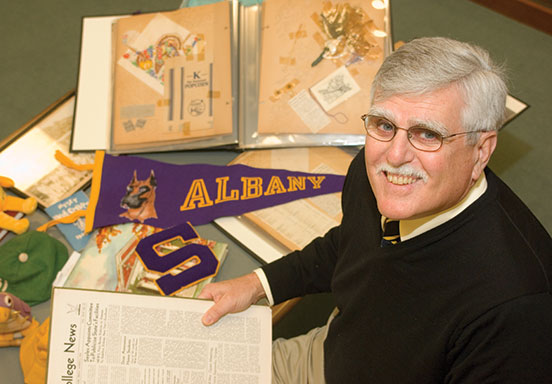Ask Geoff
Looking Back: My Years at UAlbany
By Geoff Williams, University Archivist Emeritus

University at Albany Archivist Geoff Williams, retired Sept. 2, looks back at the physical and demographic changes UAlbany has undergone in the past 27 years.
When I arrived at the University at Albany in June 1987, the first thing to strike me was the massive size of the Edward Durrell Stone-designed campus, reputedly second only to the Pentagon as a continuous pour of concrete in the United States. At that time, the University’s uptown and downtown campuses remained almost completely unchanged since the completion of Indian Quad in 1972. Only one new structure – the “bubble,” opened in 1986 near the Physical Education Building – had been added in 16 years.
There has been an enormous amount of construction since I came. The photos below highlight some of those projects; the date each building opened is in parentheses.
More capital projects have been completed, are under way or are planned for the near future. On the downtown campus, Husted Hall was completely gutted, remodeled and re-opened in 2010. Last year, the University acquired the old Albany High School as expansion space; it will house UAlbany departments while the uptown and downtown campuses are remodeled over the next decade. Construction has started on major additions to the Campus Center extensions, and new science buildings are planned for the east end of the Academic Podium. The whole podium will be renovated to eliminate asbestos while upgrading wiring and digital connectivity.
One of the first things I realized on starting work at the University was how little was known about the school’s history. Preparing for my job interview, I was unable to find any history of the State University of New York at Albany. The only published history, 1944’s College of the Empire State, was 43 years old. While shaking hands with incoming President Patrick Swygert in Fall 1990, I mentioned that our 150th anniversary was coming up in 1994. He quickly seized on that observation as a milestone around which to build the University’s first major capital campaign.
Slideshow: Construction 1988-present →
Swygert commissioned Professor Emeritus of History Kendall Birr to write an up-to-date history of the University, A Tradition of Excellence: the Sesquicentennial History of the University at Albany, 1844-1994. As the book would not be published until the sesquicentennial year, however, I was asked to provide the president a brief history of the school. Over one weekend, I created a 10-page sketch of important dates and events from 1844 to 1990 that has since evolved into a more comprehensive history of the school. The Chronological History of the University at Albany, SUNY, 1844-2008 – now about 175 pages long! – is accessible on the University Library website.
I have enjoyed writing, and speaking, too, in conjunction with my work. For several years, I’ve written “Ask Geoff” for UAlbany magazine. The column has focused on all things great and small about the University. I have also had great fun over the years guiding alumni tours of UAlbany’s campuses and speaking at a variety of alumni gatherings. Through alumni feedback, I have learned many wonderful facts about the school.
On just about every front, including student and faculty demographics, the University has changed dramatically since I arrived 27 years ago. President Vincent O’Leary, who headed the University when I first arrived, had made it a priority to have the student body reflect the general makeup of New York’s population. When O’Leary stepped down in 1990, 17 percent of the undergraduate students were African American, Asian American, Latino and Native American, and 5 percent of graduate students were persons of color. Currently, according to UAlbany’s Office of Institutional Research, those figures stand at 38 percent and 15 percent, respectively. The faculty today also more nearly mirrors state demographics. In 1990, only 20 percent of full-time faculty members were women, and 10 percent were persons of color. Today, women and persons of color account for 38 and 23 percent, respectively, of the full-time faculty.
Another dramatic change has been the decline in state support for the University’s operating budget. In 1990, that figure was 46 percent. Currently, according to UAlbany President Robert J. Jones, New York State provides just 12 percent of the operating budget.
In response, the University has sought private support. The Annual Fund started small in 1973, took off in the 1980s and exceeded $1 million dollars for the first time in 1991-92. UAlbany’s first comprehensive fundraising drive, the Campaign for Albany, raised $55 million in the 1990s. Outside funds, which totaled only $6.3 million in 1970, had grown to $105 million by 1990, and, in 2013, stood at $193 million. (That amount does not include CNSE research and contract funding.) Research grants and contracts support ground-breaking University research and stipends for graduate research assistants.
At UAlbany, my particular interest has been in expanding knowledge of and access to the school’s history, and in that I hope I have succeeded. As I leave, I wish the University – and my readers – a prosperous future. I have had a great ride as UAlbany archivist!- UAlbany Magazine
Fall 2014 - Cover Story
- Features
- Departments
- The Carillon
- Past Issues



